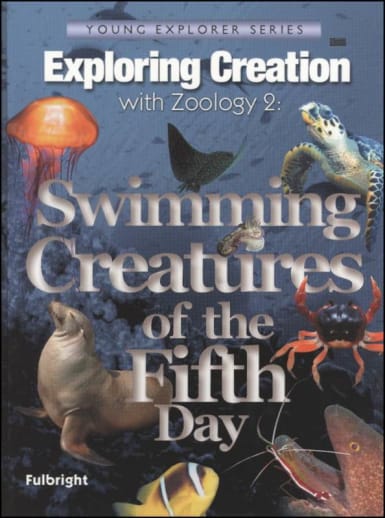Once students have learned all about the creatures of the air and the basics of zoology, they can take a trip into the depths and discover all the strange and unique creatures of the sea, lakes, and rivers. They'll learn about the special features of swimming creatures, the different watery environments they live in, what their lifestyles are like, and the special circumstances they deal with. Then they take a closer look at specific groups of swimming creatures, including whales, seals, sea cows, sea turtles, sea snakes, sea frogs and toads, primeval reptiles (like plesiosaurs), fish, sharks, rays, crustaceans, cephalopods, echinoderms, cnidarians, sponges, leeches, and more. As they study these creatures, they'll create replicas of them to add to an ongoing "Ocean Box," and conduct neat experiments like discovering the insulating power of fat, investigating how electrical current travels through salt water vs. fresh water, and determining how much of a role temperature plays in tadpole development. They'll also add to their notebooks by drawing the animals in them, comparing and contrasting animals, and much more. Whether the ocean is a familiar place to your children or not, they'll be equally fascinated by learning about the unique creatures beneath the water.
Exploring Creation with Zoology 2: Swimming Creatures of the Fifth Day
Description
From the rivers and streams to the mighty ocean, God filled the Earth's waters with animals great and small. Upon His word, enormous whales sprung into being. At His command, billions of plankton leapt to life. On that day, millions of creatures like the strapping sea turtles, the skulking sharks, the delightful dolphins, and the soaring squid gladly joined their fellow sea animals. Strong swimming bass traveled the rivers past the creeping crayfish and the sluggardly snails. How joyously crammed with excitement was the fifth day of Earth's existence!
Apologia's second zoology book will take you and your family on an exploration into the wonders of the swimming creatures made on the fifth day of creation. You'll begin with a big splash from the whales and dolphins, then spy on seals and meet manatees before swimming with the sea turtles, snakes, and salamanders. You'll even peek in on the primeval plesiosaurus and its pals.
Following your frolic with fish and sharks, you'll uncover the world of crabby crustaceans, sea snails, clams, and their soft bodied friends like the octopus, squid, and nautilus. You'll consort with corals, find flowers that devour plankton, see stars and feathers that walk, leap and roll, and discover dollars that disappear in the sand and sponges that clean more than you might think.
From the microscopic to massive, no stone is left unturned in your student's passage through the waters of the world. The creatures your student studies will come to life as your student creates replicas of them and adds them to his "Ocean Box - a miniature hand-crafted aquarium. As always, each lesson ends with an experiment or project reinforcing the scientific method and the concepts studied. Among other experiments and projects, your student will try on blubber, investigate a shark's ability to sense electrical currents, explore how whales can hear sounds that come from far away, and learn through experimentation which creatures make the best fossils. No matter how near or far you live from the ocean, you and your students will wonder at God's designs in the amazing aquatic animals He formed on the fifth day.
Apologia Science courses are written from a Biblical worldview with the homeschool in mind. At the elementary level, courses follow a Charlotte Mason-inspired methodology, with lessons organized around narration, notebooking exercises and hands-on activities or projects. Children at different ages can use these together, learning at their own level. Each course is designed to be teacher-student interactive, so teacher involvement is fairly high at this level. At the junior high and high school levels, science courses are more traditional in nature, with the textbook written to the student. Teacher involvement time at this level is much less than at the elementary level. Textbooks contain student reading, lab instructions, "On Your Own" questions and Study Guide questions. A Solutions Manual provides the answers to these and the test questions. Lab kits are available separately for both the elementary and upper-level science courses which include most of the harder to find items you will need.
| Product Format: | Hardcover |
|---|---|
| Grades: | K-6 |
| Brand: | Apologia |
| ISBN: | 9781932012736 |
| Length in Inches: | 11.25 |
| Width in Inches: | 8.3125 |
| Height in Inches: | 0.75 |
| Weight in Pounds: | 2.375 |

